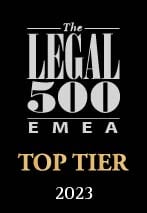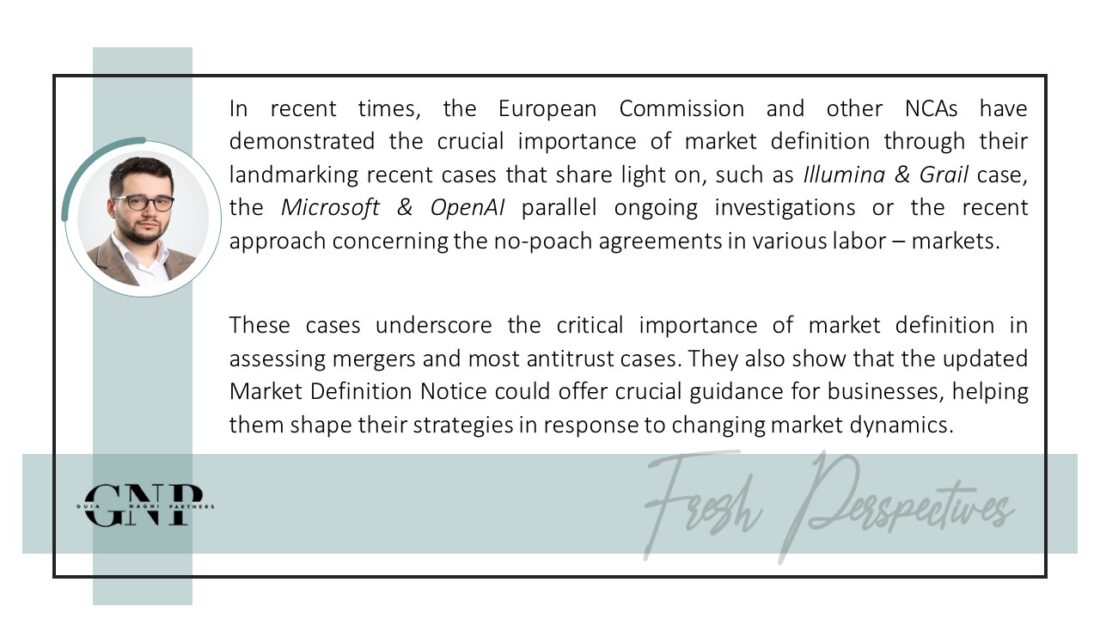Tudor Pasat – Better Late Than Never: Market Definition Notice Amended After 27 Years
On 8th of February, The European Commission (the “EC”) adopted a revised Market Definition Notice (the “Market Notice”), this being the first revision of the Market Definition Notice since its adoption in 1997. The amendment represents a consolidation of the European Court of Justice and the EC case law, being uncovered in such a way as to provide the tools for the assessment of the relevant markets in which undertakings exist, in the context of digitalization and the ongoing debut of emerging markets.
- The Market Definition Notice – Where Every Analysis Takes the Dive
The Market Definition Notice is useful not only to the EC and the National Competition Authorities (the “NCAs”) but also to companies active on the market that may asses (i) the existence/non-existence of a dominant position, (ii) the possible horizontal relationships (between competitors) or vertical relationships (between non-competitors), and (iii) the analysis of the impact on the relevant markets at stake when two or more companies carry out an economic concentration (usually M&As). This is, in fact, the first step considered in any assessment of the applicability of competition rules that cannot be skipped, as the Market Notice comes to cement the basis of the analysis through new and/or consolidated rules.
- Product, Place, and… Time (?): The Trifecta of Assessment
The Revised Notice newly puts into place a third potential coordinate of analysis, i.e. the temporary or seasonal nature of economic activities. Specifically, the peak or off-peak hours in the electricity supply market or the on and off-season periods in air transportation have been key factors in determining specific relevant markets.
Until now, (i) the relevant product market[1] and (ii) the geographic market[2] have been the primary coordinates of assessment. Although this new coordinate is not a must, considering it has been already put into practice by the EC, its consideration cannot be discarded.
Speaking of the geographic market, the Market Notice also stresses out the potential for the geographic relevant market to exhibit a global scope. Furthermore, the EC stats some key – factors in assessing the geographic market, such as: costs (being directly impacted by distance), accessible quantities, buyer’s behavior, purchasing habits, trade dynamics, shipping routes and their reliability.
Finally, the Market Notice sheds light on the EC’s vision on imports, as their commercial existence may not be enough to enlarge the scope of the geographic market itself.
- Structural changes in the market – a fence that can be hopped
The Commission asserts that it isn’t compelled to adhere strictly to market definitions from past cases for its future analyses; rather, it may use them as a starting point. This flexibility empowers the EC (and NCAs) to adapt to evolving factors such as digitalization, changes in value chains other emerging market patterns.
As such, the Market Notice clarifies that upcoming structural changes in the market will be a key – factor in shaping the market definition by anticipating future developments, including, but not limited to (i) the introduction of new products in the market, (ii) forthcoming technological developments, and (iii) imminent regulatory shifts. This applies particularly when these changes are anticipated to have a significant global impact on the markets under scrutiny.
- If it’s for free… it’s not free. Non-pricing and innovative products to be assessed
The Market Notice integrates new assessment parameters for products that do not compete on price, but rather on innovation & quality. The Small but Significant Non-transitory Decrease in Quality test has been primarily introduced in the context of of multisided digital markets assessments in cases such as EC’s AT.40099 Google Android, or in the CJEU’s Case T-604/18 Google Alphabet, these cases being its launching pad in the antitrust realm. The SSNDQ test enables the evaluation of customer switching behavior in response to a slight yet significant and enduring decline in quality and holds significance not only for highly innovative sectors but also for products offered at no cost.
Other parameters that might determine whether two apparently similar products compete in the same relevant market are the differences in terms of sustainability, efficiency, value, and variety of uses offered by the product, compatibility with other products, the image conveyed or the security and safety of the product, the privacy offered, or its availability on the market.
- Research and Development – The Sprinkles on the Pharmaceutical Cupcake
The Market Notice dedicates a distinct chapter to industries characterized by frequent and significant research and development (“R&D”) efforts.
Summarizing, the EC considers that, while initial R&D innovation efforts may not provide marketable products, they remain pertinent for assessing the product – market, should there be sufficient visibility of their R&D process to determine what other products the product under development is likely to substitute. Ultimately, the outcome could be that a producer of a product already operating on the market might be deemed to be competing with an undertaking whose product is still in its R&D stage.
This has already been put into practice by the EC in the Case M.7275 Novartis/GlaxoSmithKline Oncology Business in which the Commission considered B-Raf inhibitors and MEK inhibitors under development by the parties in the market for targeted therapies to treat advanced melanoma, where existing products were already marketed.
The EC does not stop at this scenario, addressing situations where R&D efforts cannot be attributable to a particular product. In such instances, it is precisely the R&D efforts that are the “product” under assessment. Parameters such as the nature and scale of R&D efforts, the objectives of the lines of research, the specialization of the R&D teams or the results previous innovation efforts of the company may be relevant for defining the limits within competition takes place within the R&D endeavors.
- A rain of bullets over the multi-sided platforms and digital ecosystems
The EC has focused its interest on the digital markets and their different forms of existence and interaction not only through the various regulatory measures of recent years, but also through the Market Notice, allocating them a specific chapter.
Ways in which digital markets can be determined are as follows:
- Multi – sided platforms – the EC and the NCAs may define a relevant product market for the products offered by a platform, in a way that encompasses all (or multiple) user groups, or it may define separate (although interconnected) relevant product markets for the products offered on each side of the platform.
In Romania, the Romanian Competition Council (RCC) has already done such a distinction by decision no. 86/22.11.2021 on the merger by acquisition of sole control directly by Glovoappro S.R.L. over Foodpanda Ro S.R.L. and indirectly over Delivery Hero Smart S.R.L.
The EC agrees that depending on the facts of the case, it may be more appropriate to define separate markets where there are significant differences in the substitution possibilities on the different sides of the platform, confirming RCC’s interpretation in the abovementioned case where (i) the market for restaurant food delivery services/food ordering and delivery services from restaurants; and (ii) the market for online order picking and delivery services of various consumer goods categories are different relevant markets to be assessed distinctively.
Finally, considering that, multi-sided platforms may supply a product to a user group at a zero monetary price, or even at a negative (global) price, the EC acknowledges the possibility of using the SSNDQ test and the other assessment parameters we have already touched in subtitle IV of the above in assessing multi-sided platforms and their relevant markets.
- After-markets, bundles and digital ecosystems – According to the EC,There are generally three possible ways to define relevant product markets in the case of primary and secondary products, namely:
- as a system market comprising both the primary and the secondary product;
- as multiple markets, namely a market for the primary product and separate markets for the secondary products associated with each brand of the primary product;
- as dual markets, namely the market for the primary product on the one hand and the market for the secondary product on the other hand.
Furthermore, details regarding when and/or if a system market may be a suitable approach in assessing the digital ecosystem is provided.
Specifically, the definition o a system market is more suitable if (i) the more likely it is that customers take the whole-life costs into account when purchasing the primary product, (ii) the higher the expenditure on (or the value of) the secondary product compared to the expenditure on (or the value of) the primary product; (iii) the higher the degree of substitutability between primary products and the lower the switching costs between primary products; and (iv) when there are no or few suppliers specialized only in the secondary product(s).
- Conclusions & Miscellaneous
The Revised Market Definition Notice comes with many improvements and clarifications gathered over the years based on the practice of the EC, the CJEU and the NCAs that contributed to this final form of the Notice. More than looking back, the EC is looking forward and seems to have, for the time being, secured the necessary tools to adapt to new situations and emerging markets characterized by digitalization and competitiveness through research, development, and innovation.
Still more, for the enthusiastic economists working closely with Competition Law consultants, the European Commission provides in the final part of the Notice guidelines for computing market shares, ensuring a degree of enforceability of the proposed new guidelines.
[1] Generally assessed as the totality of interchangeable products in terms of characteristics, price, end-use and market supply and demand structure
[2] Generally assessed as the geographical area in which the undertaking operates and where the conditions of competition are sufficiently homogeneous in order to be distinguished from other geographic areas.





No Comments